The fields are turning golden brown from the emerald green of spring. The rolling hills of Tuscany shimmer from the heat of the summer sun. This is August when many Italians take their holiday, and it is the time of festivals in Tuscany.
Love the sound of Tuscany and Montepulciano?
Just a 20-minute drive from Montepulciano is the independent holiday getaway of Cignella. The former Tuscan farmhouse has been converted into nine self-contained villas and four apartments, each with their own personality and unique style. Daily breakfast can be added to the booking and facilities include a swimming pool (open May to October) surrounded by a raised lawn with plenty of seating and sun loungers. To make the most out of the region Cignella recommend bringing a car – there is private parking onsite.
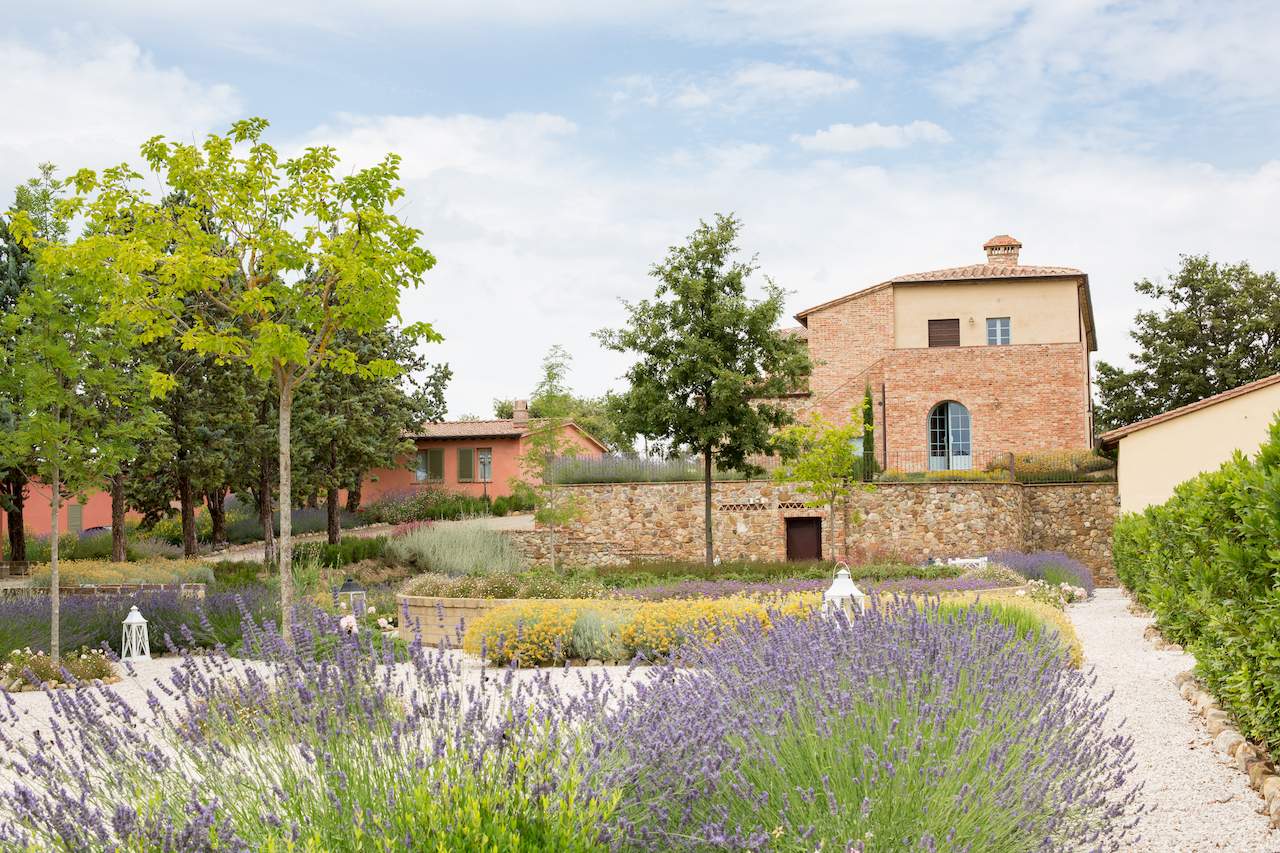
All guests who book an apartment or village directly with Cignella will receive a welcome kit with necessities such as bread, milk, juice, eggs, tea, coffee, butter and of course pasta, plus basic kitchen cleaning products. Prices start from €900 per week for an apartment/villa and €89 per night (room only).
Ferragosto, the Night of Saint Lorenzo & The Bravio
There is the Ferragosto, the Night of Saint Lorenzo, the famous Palio of Sienna and a lesser known but highly entertaining weeklong Renaissance style celebration in the hilltop village of Montepulciano called the Bravio delle Botti.
The festival takes place on the last week of August along the main streets of the town. It is an original challenge between the eight Contradas, neighbourhoods, of the village that compete for a painted cloth banner.
Rolling the barrel
The Bravio is the actual name of the beautifully painted banner bearing the image of the Patron Saint of the town, Saint Giovanni. Two athletes from each neighbourhood, called Spingitori, roll a 160lb empty wine barrel in an uphill race for over a mile along the streets of the town until they reach the front of the Cathedral in the Grand Plaza.
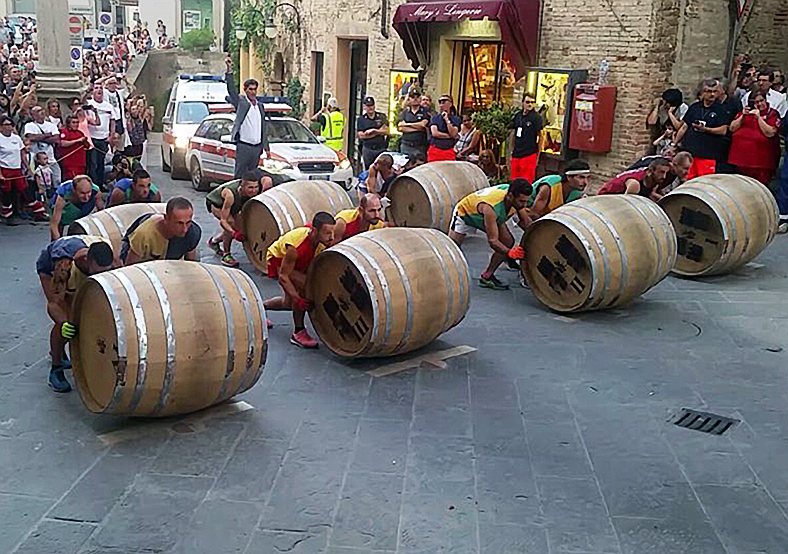
Battle of the barrels (c) Jim Chamberlain
This a grueling physically demanding exertion that can be full of surprising drama. Barrels turn sidewise or crash into each other throwing the athletes into frustrating efforts to keep from falling behind the leaders.
Montepulciano celebrates for a week prior to the race. Each Contrada will parade through the main square. Its residents dressed in Renaissance clothing in the colours of their district.
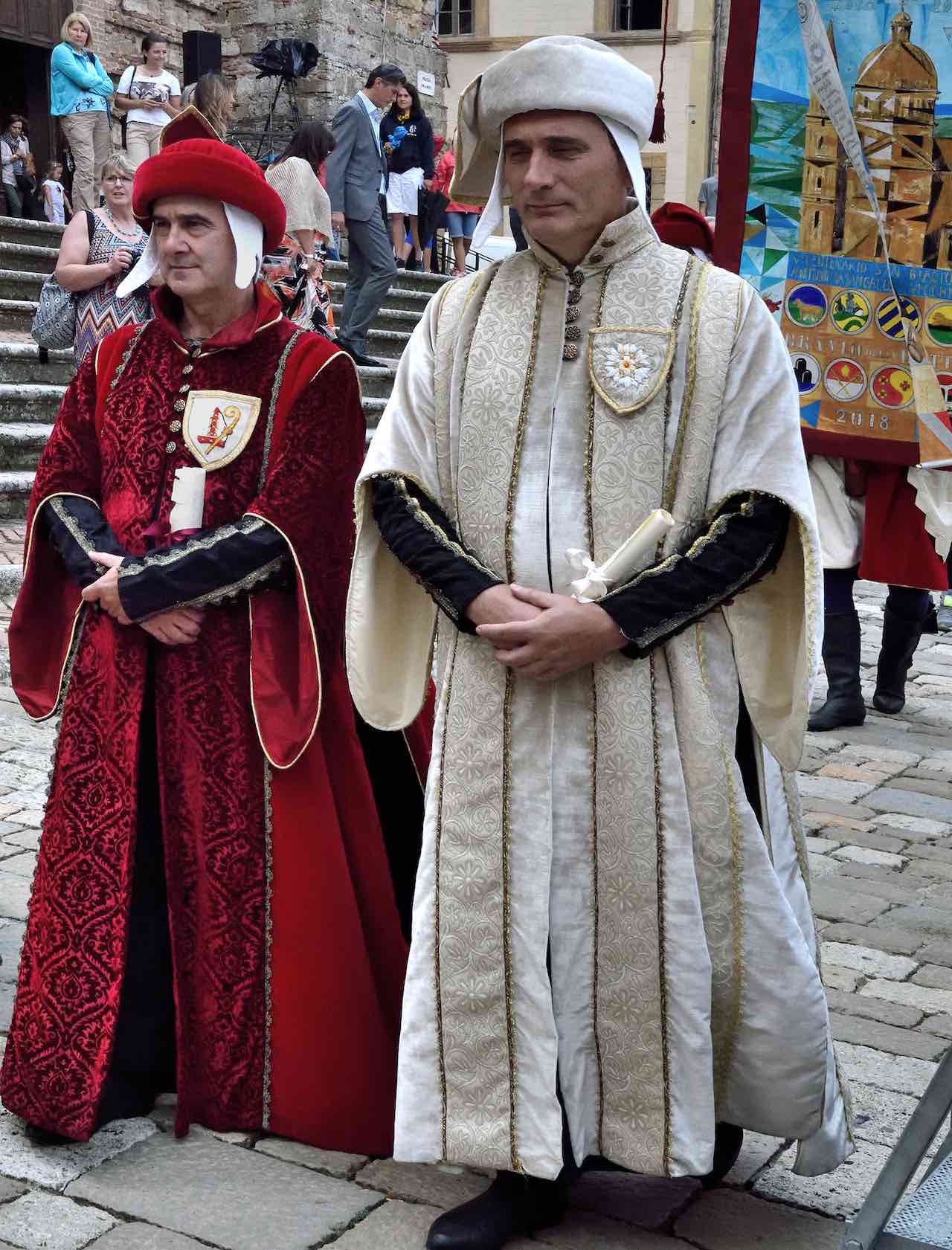
Noblemen and Bravio (c) Jim Chamberlain
Communal dinners are held in the neighbourhoods and the whole village is decorated in the colourful flags of the 8 districts. Heralds trumpet out each parade from the windows of the medieval town hall with its crenellations and tall tower called the Palazzo Comunale whose central tower dates back to the 16th century and reminds you of the Palazzo Vecchio in Florence.
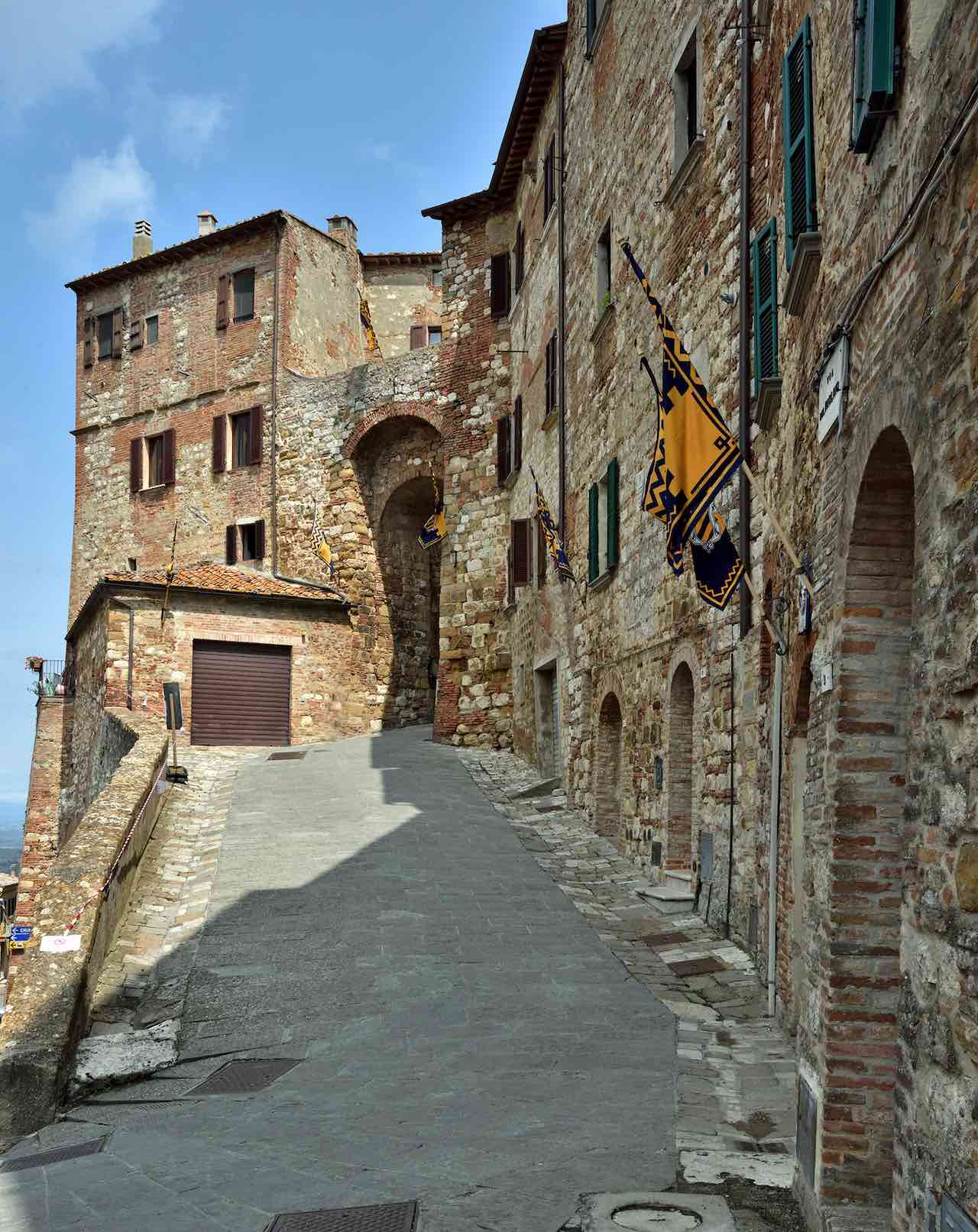
Streets of Montapulciano (c) Jim Chamberlain
I was fortunate to witness the parade of one Contrada. The whole town dressed in their finery sat in the stands around the square and watched the representatives of the Contrada Talosa in gold and red costumes, with large flags and drummers march into the square.
The flag bearers performed difficult flag waving and tossing of their large banners into the air and catching them before they hit the ground to beat of their drummers.
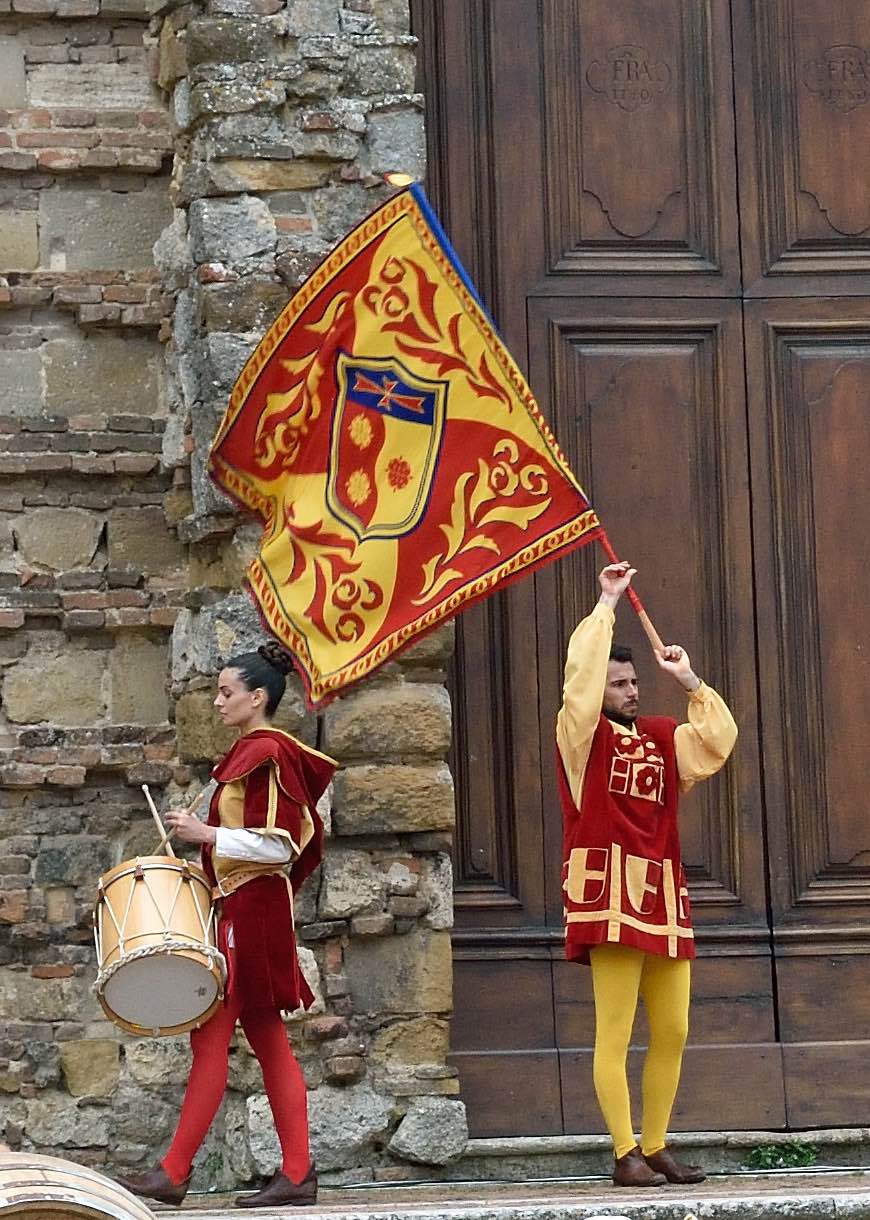
Flag Waver (c) Jim Chamberlain
Later in the day, I saw the town magistrates parade the Bravio through the square dressed in their medieval finery with the symbol of the town, a Griffin, on their costumes. A spectacle to remind one of the pageantries of the Renaissance.
The festival started back in 1373 as a horse race between the regions like Sienna’s, race around the El Campo. Today’s names of the Contradas are the same that have always been. They are the Cagnano, Collazzi, Coste, Gracciano, Poggiolo, San Donato, Talosa, and Voltaia. They maintain the same colours, coat of arms and ceremonial parades as they have for centuries.
The horse race for the Bravio continued until the 17th century when it was stopped to maintain public order. The recent history of the Bravio began in 1974 when a local priest had the suggested the swapping of the old horse race for a barrel race. The oak barrels are an important symbol of Montepulciano. Only here is the famous wine, Vino Nobile di Montepulciano, aged in them.
Vino Nobile di Montepulciano
Vino Nobile di Montepulciano wine must come from vineyards on the hills which surround Montepulciano. The key grape variety grown here is Sangiovese. Sangiovese grapes must make up at least 60–80 percent of the final wine. The aging period for any Vino Nobile di Montepulciano is a minimum of 24 months (36 months for the Riserva wines), of which at least 12 months must be spent in oak barrels. Local winemakers have long used large Italian botti.
The larger barrels provide less oak flavour in the finished wine. Oak barrels are used here not so much for their flavour as for the slow, controlled ageing they provide. This tradition has now become enshrined in the Vino Nobile di Montepulciano DOC laws.
While visiting Montepulciano make sure to visit the Ricci family winery, The Cantina di Ricci. It is located just off the city center and it is one of the best winery tours you will ever take.
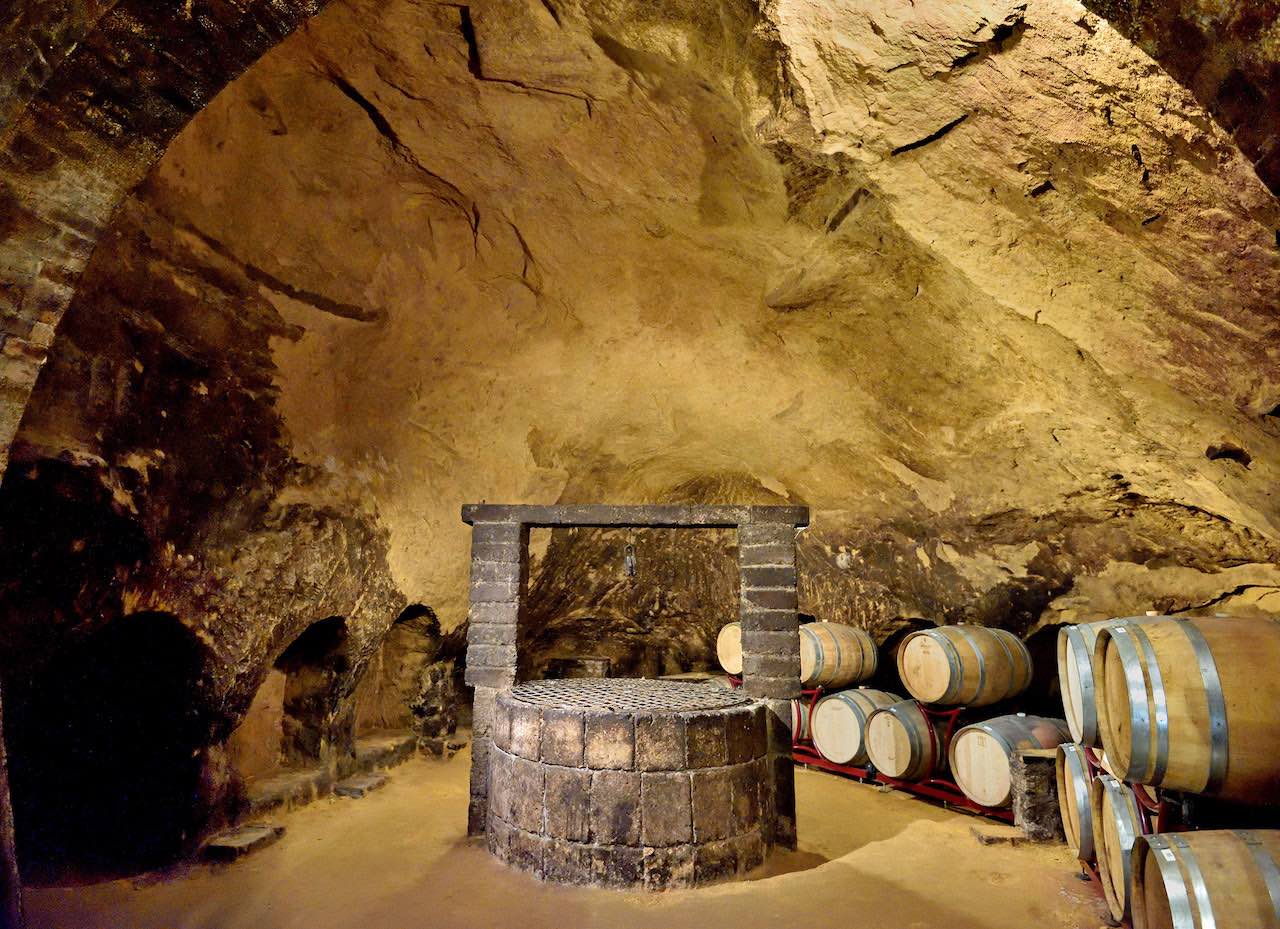
Etruscan Cave (c) Jim Chamberlain
You meet your guide in a large outdoor patio with views of the Tuscan countryside and the church of San Biagio. The tour takes you down an equestrian brick staircase several floors where you will see huge black wine barrels of Slavonian oak, wooden wine presses, and a golden cave where the Etruscans stored their wine before the time of Christ. The cellar is roofed by a monumental succession of arches and sustained by massive pillars which together reminded me of a Cathedral. This tour finishes with a tasting of three vintages of the Vino Nobile with appetizers. The wine is full bodied, elegant, and a deep red. It has been heralded as one of the best wines produced in Tuscany.
Festivities prior to the festival
The entire week prior to the race is full of important events. Each evening will be the official trial of the “Spingitori” to test their worthiness to compete in the race. Each Contrada will be open to welcome anyone who wishes to stop by with food, games, music, and wine!
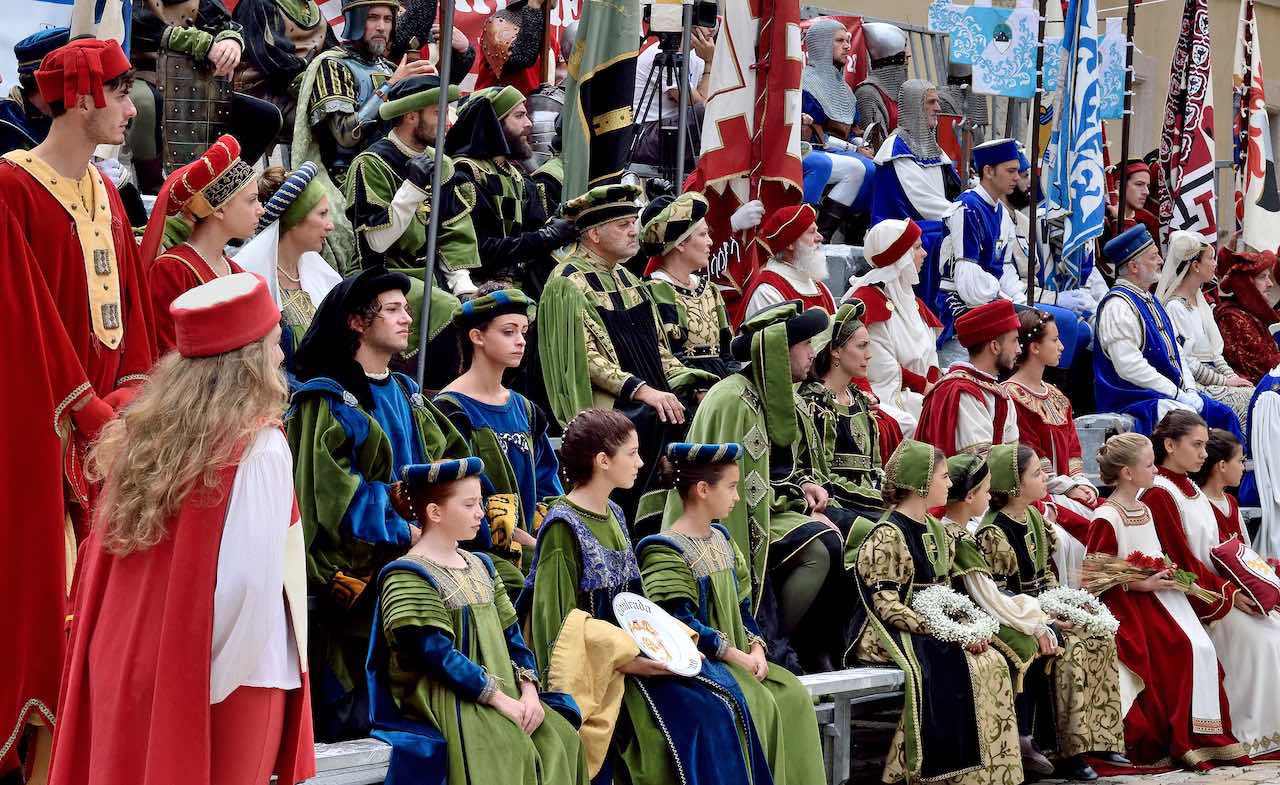
People of Montepulciano (c) Jim Chamberlain
On the last Sunday in August at 3.00 PM, the procession, consisting of more than 300 partici-pants, commences through the historic village. Finally, the signal is given by the ringing of the town hall bells at 7 P.M. The barrels begin to roll on the stones, leaving from the Marzocco’s column.
The athletes push their barrels with trained hands up the narrow steep lanes. Residents and visitors alike crowd narrow doorways as the huge barrels are rolled by. Everyone is cheering for their favorites as the athletes compete for the lead. Only one Contrada will be able to celebrate the victory and claim the Bravio. The other Contradas will be disappointed but will applaud the winner. A story that is till repeating itself after 600 years.
This year the team of the Poggiolo Contrada in their colours of Blue and White won the race and was proudly handed the Bravio.
While the horse race of Sienna is more famous, the battle of the barrels in Montepulciano is a Tuscan festival worthy of your time to visit. The wine here is better than in Sienna too.
Disclaimer: this article is sponsored by Cignella
